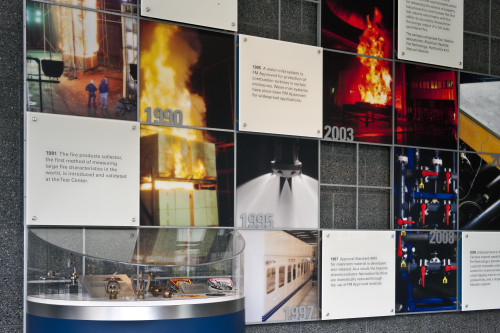
FM Global’s historic time line and sprinkler display
FM Global, Johnston, Rhode Island, Norwalk, Connecticut, 2010
Description
Project brief: As an in-house design agency for FM Global, our clients are internal, from various departments throughout the company, although our audience or ultimate end user is frequently external, e.g. the policyholder or general public. For this particular project, our research department called on us to create inventive displays for the visitors’ area of our Research Campus, one of the most innovative research and testing centers in the world, to showcase our 175-year history of innovation. The driving force behind the project, which spanned just nine months from concept to installation, was a significant client event taking place at the Campus in celebration of our 175th anniversary. Although we had already created an historic time-line display several years earlier, an addition was recently put on the building, which resulted in the need for changes to the display. While existing content could be repurposed, a new design was created, along with an idea for a display case to house 1,000 historic sprinklers from our collection. Several factors had to be addressed for this sprinkler display: first, how to secure each sprinkler so there is no movement or theft; second, how to create a display that does not need a great amount of attention, e.g. dusting each sprinkler; and lastly, how to display these sprinklers to show the true progression of the sprinkler from 1880 to present, cataloguing each for a to-be-developed companion brochure.
Approach: Two concepts were created by the art director for the time-line display and the sprinkler display, and were presented to several tiers of management. Several vendors were interviewed to obtain their perspectives on how to construct exhibits from the designs, especially the idea of “suspending” the 1,000 sprinklers in glass cubes. The final vendor, Orion RED, was chosen because it was the only vendor that could stay true to the designs.
The concept was to create industrial artwork for the expansive (and empty) lobby at the Research Campus. The sprinkler display is the “painting,” with a mosaic glass background and a Plexiglas cube system to house each sprinkler. These cubes then were suspended by a custom-built metal grid system with a grip mechanism for each sprinkler, and the entire case was encompassed in glass with a thick wood frame. The historic time-line display is the “sculpture.” Its “bones” mimic the metal grid system used in the sprinkler display; milestones are highlighted on silk-screened glass cubes and printed photos are suspended on the grid at different levels from the wall. Pops of the same color from the mosaic appear behind the suspended glass for a touch of color.
The design took a month, approvals took an additional two months, then art production and material production took the remainder of the time, with a two-week installation. The team included the art director, project managers on the client and vendor sides, a writer, production designer and installers (not to mention the historian, sprinkler expert and electrician).
Effectiveness: The exhibits were part of an anniversary event for our clients and they were well received, both by our executive-management team and our clients alike. As a show of appreciation, the executive sponsors hosted a recognition luncheon for all involved (more than 30 people) a month after the unveiling. This exhibit actually replaced an existing historical time-line display that was only slightly out-of-date but received a less-than-glowing response when it was installed seven years ago. That existing display (composed of 12 etched-glass panels) was designed and executed by an outside design agency and cost the same amount of money as the new exhibit that contains our historic time-line display, as well as the sprinkler display. So for cost-effectiveness, the savings were substantial. We also believe the sprinkler exhibit is the largest collection of historic sprinklers currently on display.
Credits
- Design firm
- FM Global, Johnston, Rhode Island
- Creative director
- Jennifer Cournoyer
- Production artist
- Stephen Pine
- Writer
- Patty Iannotti
- Project manager
- Sara DeMille
- Structural designer
- Orion RED
- Fabricator
- BENCHMARK Building Company, Inc.
- Client
- FM Global





